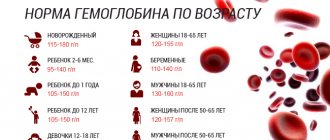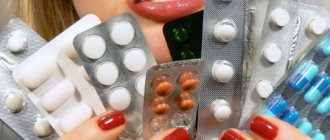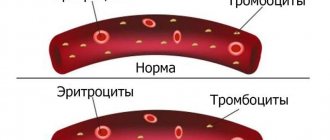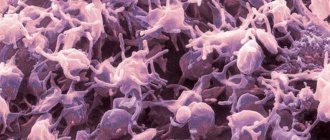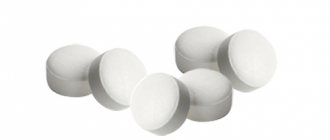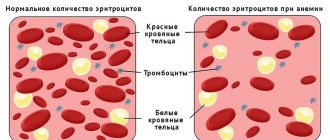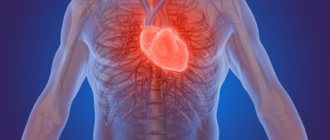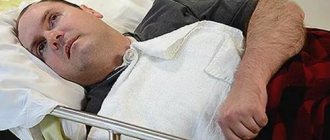With the normal functioning of all organs and systems of the body, the amount of hemoglobin in human blood is within a certain range. But there are physiological and pathological conditions in which the Hb level goes beyond its normal limits. The most common of these conditions is anemia. Almost every adult has heard about them, and many have encountered them personally. More rare, but no less dangerous, is the other extreme - high hemoglobin in the blood or hyperhemoglobinemia. This disease occurs not only in adult men and women, but also in children.
Red blood cells in the bloodstream
Increased hemoglobin in women and men: how to determine
The causes of elevated hemoglobin in adults are practically the same, but the pathology is more severe in men than in women. It is important to take into account that it is difficult to determine it by symptoms, since a person has them with various diseases: headache, weakness, tingling in the limbs, itching, redness of the skin, bleeding gums. The easiest way to identify high levels is with a general clinical blood test.
Increased hemoglobin: symptoms in women
Small increases in hemoglobin in women do not cause symptoms. As it progresses, the following may appear:
- heaviness in the head;
- dizziness;
- tinnitus;
- decreased vision;
- chilliness of the limbs;
- burning or tingling in the fingertips;
- itchy skin that gets worse after a warm bath or shower;
- dilated capillaries, spider veins on the skin of the face and lower extremities;
- fatigue;
- insomnia.
Watch the video about the symptoms of high hemoglobin:
Signs of elevated hemoglobin in men
In men, the signs of increased hemoglobin are usually more pronounced:
- red skin of the face and neck, hands;
- redness of the eyes;
- intense headache and joint pain;
- pain in the heart area;
- increased blood pressure;
- bleeding gums;
- A small blow will cause bruises.
Due to an increase in the level of uric acid formed during the exchange of hemoglobin, gout develops and renal colic occurs.
Hemoglobin is increased - what does this mean for a person?
An increased level of hemoglobin indicates that there are more of its carrier cells, that is, red blood cells.
Because of this, the blood becomes more viscous and has difficulty moving through the vessels. As a result, blood clots and blood clots can form. This leads to heart attacks and strokes.
If the hemoglobin content in the blood is reduced, then the person has iron deficiency anemia. Hemoglobin higher than normal indicates changes in the body that lead to health problems.
Sometimes high rates are the result of chronic conditions. Or, as the volume of fluid in the blood decreases, the concentration of red blood cells increases.
Also, a lack of oxygen (hypoxia) in some area of the body can cause an increase in hemoglobin. In addition, some foods increase hemoglobin in the blood.
Why is hemoglobin elevated in children?
Hemoglobin is elevated in children most often due to intestinal infections, dehydration, severe vomiting and diarrhea. Since the regulation of water-salt balance in a small child is still developing, blood thickening often occurs during viral, bacterial and inflammatory processes, when they occur with a high temperature.
The reasons why indicators increase may be:
- congenital diseases (heart defects, blood diseases);
- structural anomalies of the renal artery, kidneys;
- blood cancer, kidney and liver tumors.
A tumor in the kidney is one of the reasons for increased hemoglobin
How to reduce hemoglobin?
If with low hemoglobin the cause may be an elementary iron deficiency, then with hyperhemoglobinemia everything is somewhat more complicated. The cause of high hemoglobin is oxygen starvation of the body, dehydration, chronic stress or oncology of organs directly or indirectly involved in the process of hematopoiesis.
For chronic hypoxia
Treatment of high hemoglobin during oxygen starvation will depend on the level of oxygen deficiency in the body:
- If there is a deficiency of oxygen in the air, change your job, lifestyle or place of residence
- If pulmonary ventilation is impaired, stop smoking and take a course of treatment for chronic respiratory diseases.
- Chronic carbon monoxide poisoning - finding the cause of carboxyhemoglobin formation and eliminating it
- Low hemodynamics - treatment of chronic cardiovascular diseases, elimination of blood thickening
For stress
Chronic stress can lead not only to hemodynamic disturbances, but also to an increase in the production of glucocorticosteroids in the adrenal cortex, which leads to an increase in red blood cells and hemoglobin in the blood.
To reduce hemoglobin levels during psycho-emotional stress, it is better to consult a specialist - a psychologist or psychotherapist (depending on the situation and severity).
For oncology
This is perhaps the most dangerous and difficult cause of hyperhemoglobinemia to treat. Depending on the location of the cancer pathology, treatment may include surgery, chemotherapy and radiation therapy. But most often a combination of these treatment methods is used.
In extreme cases, when it is not possible to influence the underlying cause, and the number of red blood cells and hemoglobin levels are so markedly increased that they pose a threat to the patient’s health, drugs that inhibit erythropoiesis may be prescribed. One such drug is sodium phosphate. Treatment is carried out strictly in inpatient facilities under the supervision of the attending physician.
Why is high hemoglobin dangerous?
High hemoglobin is dangerous for vascular thrombosis. Thick blood quickly coagulates into clots, and they block the lumen of veins, capillaries and arteries. This leads to the following consequences:
- trophic ulcers on the skin of the lower extremities;
- blockage of the veins of the liver, intestines with difficulty in blood outflow and dysfunction;
- thrombosis of the branches of the pulmonary artery (life-threatening condition);
- stroke;
- myocardial infarction.
High hemoglobin is also bad because intravascular coagulation threatens bleeding (from the veins of the esophagus, gums, nose, stomach, uterus, intestines). This is due to the fact that during thrombosis, coagulation factors are intensively consumed, so a small injury to the vessels is enough to create a risk of blood loss.
Thrombosis due to increased hemoglobin
Average hemoglobin content in a red blood cell: concept
To maintain normal functioning, the body needs a certain number of red blood cells. But their quality is no less important. This is due to the fact that the body experiences a deficiency of nutrients and oxygen if red blood cells do not contain enough hemoglobin.
The latter is a protein compound consisting of 4 peptide molecules, which, in turn, are associated with iron-containing complexes (hemes). In both vertebrates and humans, hemoglobin is the main component of red blood cells. It is capable of both attaching oxygen molecules to itself and giving them to the cells of the body.
In the conclusion drawn up after a blood test, it is worth paying attention to 2 indicators:
- MSN. It reflects the absolute content of hemoglobin in the red blood cell. This indicator changes with age.
- MCNS. This is the most informative index. It reflects the average hemoglobin content in red blood cells. An increase or decrease in concentration, as a rule, indicates the development of a pathological process in the body.
Both indicators are considered together when diagnosing various diseases.
High hemoglobin: what to do
With high hemoglobin, it is necessary to treat the disease that caused this disorder: drinking water (30-45 ml/kg) and intravenous administration of solutions for dehydration, antitumor medications for erythremia, surgery, chemotherapy for a tumor.
Heart and pulmonary failure requires therapy in accordance with the disease, and additionally prescribed blood thinning drugs (Plavix, Warfarin), a diet with limited meat products, folk remedies (leeches, mistletoe, sweet clover, cherry leaf).
Treating Changes
Treatment of hyperhemoglobinemia depends entirely on the cause of its occurrence:
| Cause of hyperhemoglobinemia | Treatment |
| Dehydration | Drinking water and intravenous administration of solutions; for intestinal infections, mixtures of electrolytes (salts) are recommended - Regidron, Gastrolit, Ringer |
| Erythremia | Bloodletting, removal of red blood cells from the blood (erythrocytapheresis), antitumor agents (Cyclophosphamide, Imifos), administration of radioactive phosphorus |
| Heart and pulmonary failure | Therapy is aimed at the underlying disease, and Curantil, Aspirin, Plavix, Warfarin, Fraxiparin are used to thin the blood. |
| Tumor | Removal, chemotherapy, radiation |
How much water to drink with hyperhemoglobinemia
The need for drinking water during hyperhemoglobinemia is calculated depending on the degree of dehydration, but the standard dosage for physiological increase is 30 ml per 1 kg of body weight for an adult and 30-45 ml/kg for a child. At the same time, it is important to drink water without gas and additives, compote without sugar from berries or dried fruits. Tea and coffee are not recommended as they have a diuretic effect.
Diet to normalize the condition
Dietary nutrition to improve general condition should prevent blood thickening and an even greater increase in indicators due to the supply of iron.
The diet minimizes:
- meat, fats, offal;
- salty, spicy, fatty and fried foods;
- alcoholic drinks;
- strong tea and coffee;
- peanut.
It is important to include in the menu:
- boiled and steamed vegetables;
- whole grain porridge, except buckwheat;
- legumes;
- some fish and seafood;
- fruits and berries.
Nutrition without eliminating the cause of the increase in hemoglobin has low effectiveness, so it is used only in combination with medications.
Blood thinners
Folk remedies for reducing hemoglobin
Folk remedies for reducing hemoglobin can be recommended solely to prevent increased thrombosis , since they will not reduce protein levels in the blood, but can reduce its viscosity. For this purpose:
- leeches (hirudotherapy);
- mistletoe infusion - a teaspoon per 300 ml of hot water, leave for 2 hours, take a tablespoon before each meal for 15 days, then need a break for a month;
- a collection of cherry leaves (50 g), sweet clover herb (10 g) and hawthorn flowers (40 g): pour a tablespoon of boiling water into a thermos overnight, take a third of a glass 3 times a day before meals for 1 month.
We recommend reading the article on blood hemolysis. From it you will learn about the types of hemolysis and the reasons for its appearance in a biochemical blood test, why the indicator is dangerous, the norm and deviations in the analysis. And here is more information about increased bilirubin in the blood.
An increase in hemoglobin occurs physiologically (sports, high-altitude climate), with smoking, stress, as well as diseases with dehydration, pulmonary and heart failure. High rates are found in erythremia and renal artery stenosis. With minor changes there are no symptoms, then headache, high blood pressure, and itchy skin appear.
A complication of hyperhemoglobinemia is vascular thrombosis, there is a risk of stroke and heart attack. Treatment is aimed at eliminating the cause, thinning the blood, and is supplemented by drinking regimen, diet, and folk remedies.
What is hyperhemoglobinemia
Hyperhemoglobinemia - this term means an increase in hemoglobin above the generally accepted norm in medicine. If you look at the norms of hemoglobin in the blood for children, women and men, the criteria are the following values:
- For women - above 160 g/l
- For men - above 170 g/l
- During pregnancy - above 150 g/l
- For children on their 1st birthday - more than 225 g/l
- For a one-week-old child - more than 215 g/l
- For a one-month-old baby - increase from 180 g/l
- For a one-year-old child - an increase from 145 g/l
Reasons for the increase
Increased hemoglobin is caused by various reasons: both physiological (natural) and pathological (diseases). For children, congenital diseases and defects will be more relevant, for men and women - acquired ones.
Let's first look at the physiological causes of high hemoglobin levels:
- In case of secondary erythrocytosis associated with generalized long-term (chronic) hypoxia: with altitude sickness, chronic obstructive pulmonary diseases, congenital “blue” heart defects, carboxyhemoglobinemia (in heavy smokers), hemoglobinopathies with increased affinity of Hb for oxygen, deficiency of 2,3-diphosphoglycerate in red blood cells, prolonged stay in places with low oxygen content. Such erythrocytosis is associated with an increase in the number of red blood cells (hemoglobin) against the background of an increase in the production of erythropoietin due to tissue hypoxia.
- Also, an increase in hemoglobin against the background of blood thickening (hemoconcentration): with stress, dehydration, Gaisbeck syndrome, pseudopolycythemia. These are so-called secondary relative erythrocytosis, in which there is a relative increase in red blood cells per unit volume of blood, but the total number of red blood cells and hemoglobin remains at the same level. Even donating blood on a hot day after a short run can lead to an increase in the amount of Hb in the analysis.
Hemoglobin in the blood can be increased in the following pathological conditions and diseases:
- With increased division of erythropoiesis precursor cells due to tumor transformation of a polypeptide stem cell, which is observed with erythremia.
- With secondary erythrocytosis not associated with tissue hypoxia. Such red blood cells are associated with an increase in the amount of red blood cells (hemoglobin) against the background of an increase in erythropoetin production with tumors: hypernephroide kidney cancer, cerebellar hemangoblastom, lindau gippel syndrome, hepatoma, cortical tumors, adrenal glands of adrenal glands, adenoma and hypophase. Kulinizing ovarian tumors .
- Due to increased erythropoiesis under the influence of glucocorticosteroids. In this case, the absolute number of red blood cells also increases, which leads to increased hemoglobin.
Sometimes finding the reason why hemoglobin is elevated is not easy, because... may require more extensive testing than just blood tests and medical history.
Symptoms
Possible symptoms of increased hemoglobin may include:
- Weakness
- Dyspnea
- Drowsiness
- Headache
- Increased blood pressure
- Increased fatigue
- Decreased immunity
But the main sign is the detection of an Hb level higher than normal in a general blood test, because All of the above symptoms may not be obvious.
Diagnosis of the problem
What tests should be done to determine if a patient has a high hemoglobin level? Doctors just need to refer the man for a clinical blood test. However, to identify the pathology that provoked hyperhemoglobinemia, additional instrumental studies will be required.
The results obtained during the analysis are compared with standard hemoglobin values. These indicators vary for both sexes by age.
| Number of years | Women (g/l) | Men (g/l) |
| From 12 to 14 years | 115 – 150 | 120 – 160 |
| From 15 to 18 years old | 115 – 155 | 115 – 165 |
| From 18 to 44 years old | 117 – 155 | 132 – 173 |
| From 45 to 64 years old | 117 – 160 | 131 – 172 |
| From 65 years and older | 117 – 161 | 126 – 174 |
Article on the topic:
What do elevated platelets in women indicate? Causes, symptoms and treatment
Treatment
To reduce high hemoglobin in men, the reasons for its increase are first identified, then appropriate treatment is prescribed.
- For primary diseases, comprehensive therapy is carried out, aimed at eliminating them and reducing hemoglobin.
- If excess iron-containing protein is caused by certain lifestyle factors, the program of action is different. It is recommended to reduce the intensity of physical activity or reduce the number of cigarettes smoked, or even better, quit smoking.
Aspirin is an inexpensive but effective drug
Drug treatment
Drugs that thin the blood are prescribed:
- aspirin;
- trental;
- cardiomagnyl;
- chimes.
Procedures
In special cases, when it is necessary to reduce blood viscosity, and medications do not give the desired effect, it is necessary to do blood electrophoresis or blood transfusion.
ethnoscience
Many herbs have the property of thinning the blood no worse than aspirin:
- sweet clover;
- licorice;
- angelica;
- sage.
But before you make a decoction or infusion from the herb and start treatment at home, you should consult a doctor. Many herbs have side effects and can harm the body.
Hirudotherapy reduces blood viscosity
Bloodletting and hirudotherapy (treatment with medicinal leeches) have proven themselves well in the fight against excess hemoglobin.
Diet
Correcting your diet will help normalize hemoglobin levels. You need to eat less meat and increase plant foods in your menu, with the exception of red vegetables and fruits.
Additional information on the topic “High hemoglobin in men: causes and treatment” can be obtained from the video:
How to lower hemoglobin
If hemoglobin is within normal limits and does not exceed 162–163 in a man, or is slightly higher than normal and is 172–176, there is no need to specifically do anything that would specifically reduce hemoglobin in the blood.
But if a man’s hemoglobin is really high, and the test results are 190 or higher, then he needs to be treated under the supervision of a doctor, and regularly test for ferritin, which will help identify the real cause of the failure.
Nutrition
First of all, adjust the diet. To normalize high hemoglobin in a man, you need to eliminate everything that causes it to increase in the blood. These products include:
- meat;
- offal;
- red berries, vegetables, fruits;
- mushrooms.
You can’t completely eliminate iron from your diet, but it’s better to get it from plant foods.
You need to avoid uncontrolled use of vitamin-mineral complexes. And not only from those that contain iron, but also from vitamins with a high content of folic acid, B12, copper, zinc, which promote the absorption of Fe.
It is useful to introduce fruit salads into your diet. To prepare a salad that can be eaten daily for breakfast, take banana, apricot, and grapes.
Useful for thick blood are cucumbers, zucchini, garlic, onions, and peppers. It is advisable to regularly add them to food, but not to overdo it. These foods contain a lot of vitamin C, which should be consumed in moderation if you have high hemoglobin.
Ways to reduce Hb
If you have elevated hemoglobin, you cannot limit yourself to diet. The patient may require treatment that cannot be self-administered. For example, aspirin, which thins the blood, can cause stomach ulcers.
To reduce Hb, erythrophoresis may be required - a procedure for removing part of the red blood cells from the bloodstream. They also resort to treatment with pharmaceutical leeches, medications and the properties of medicinal plants are used.
If hemoglobin is high, donate blood, which in men should be 1/10 of the total volume; this can be done no more than once every 2 months. This frequency of blood donation allows the body to fully recover.
Regular donation reduces blood viscosity and reduces Hb levels to normal values.
